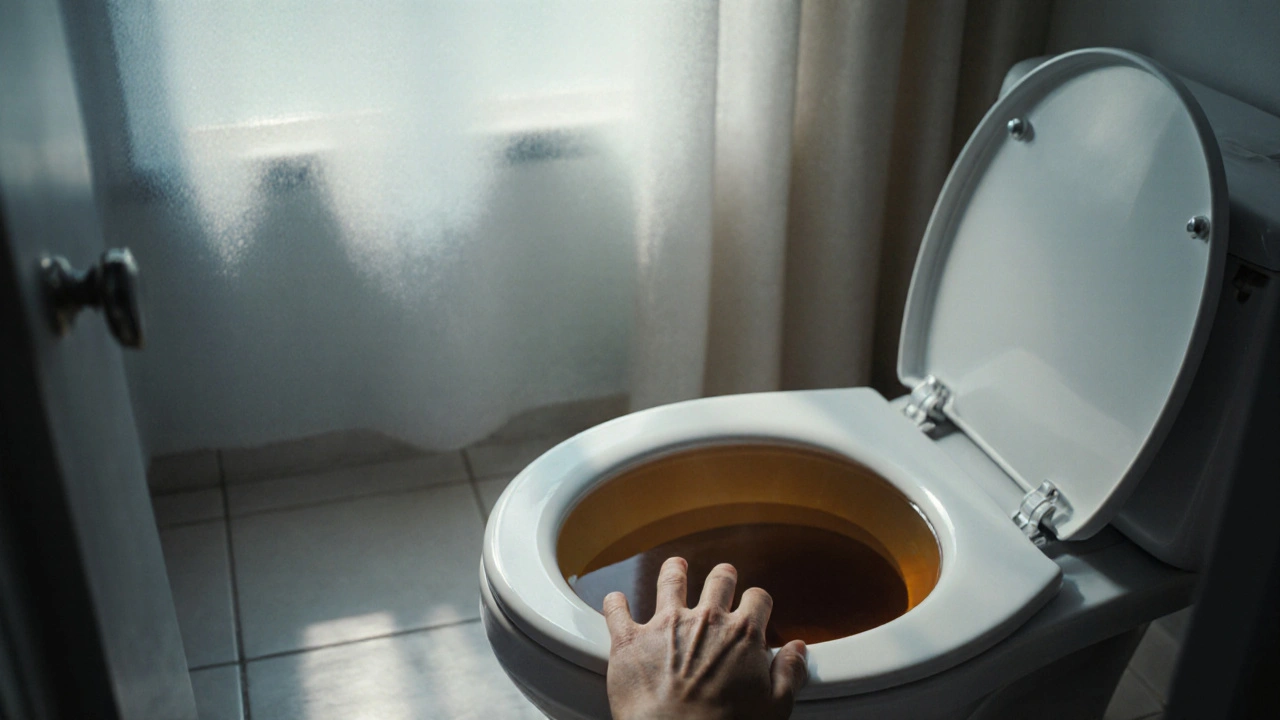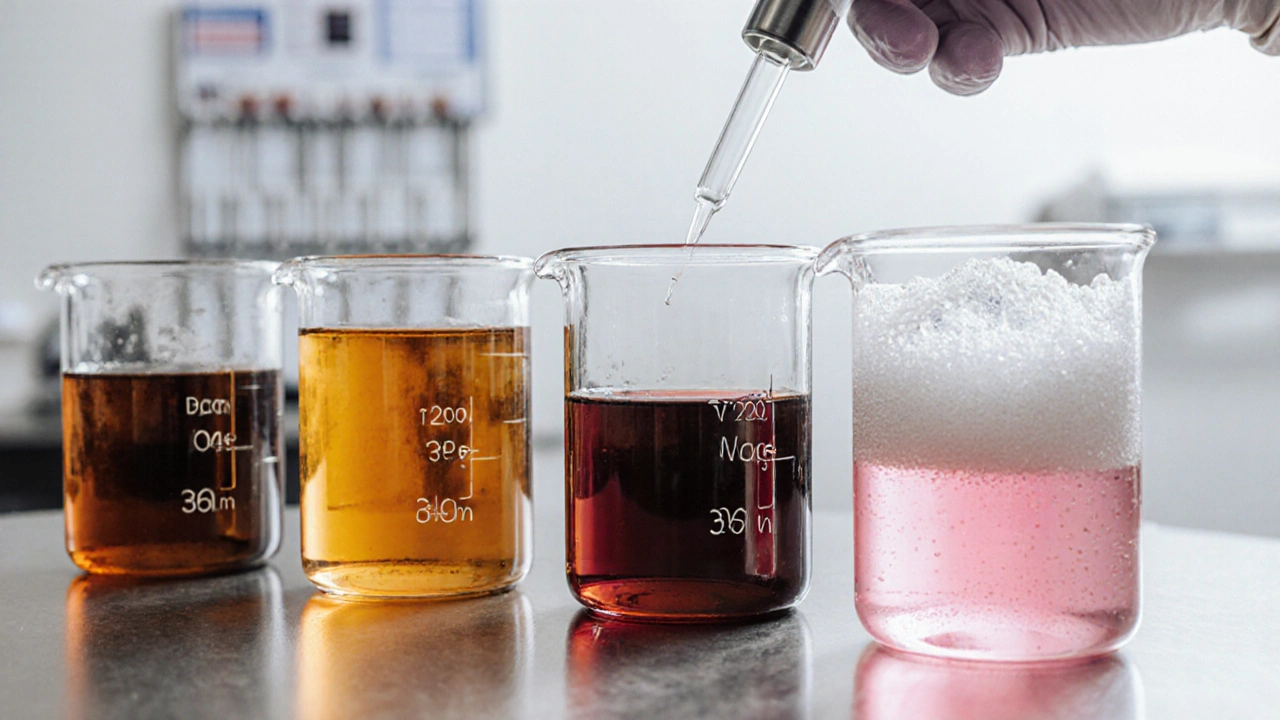
Urine Color Assessment Tool
Urine Color Checker
Your Assessment
When Kidney failure is the gradual or sudden loss of the kidneys' ability to filter waste, balance fluids, and regulate electrolytes, one of the first clues can be the color of your urine. Your body often tries to tell you something before you feel pain or notice swelling.
Why urine color matters
Urine is a waste fluid made up of water, salts, urea, and a few other by‑products. Its hue depends on the concentration of pigments like urochrome, the presence of blood, or other substances that the kidneys aren’t clearing properly. When the kidneys start to fail, the balance shifts and color changes become more noticeable.
Typical urine colors in kidney failure
Below are the most common shades you might see if your kidneys are in trouble:
- Dark amber or tea‑colored - a classic sign of high urea and creatinine levels (uremia). The urine looks almost like strong black tea.
- Orange or cola‑like - can indicate a buildup of bilirubin or certain medications that the failing kidneys can’t clear.
- Brown or “coca‑cola” brown - often linked to myoglobinuria, where muscle breakdown releases myoglobin that the kidneys can’t filter.
- Pink or red - may signal hematuria (blood in the urine), a symptom of advanced chronic kidney disease or infection.
- Foamy or bubbly - excessive protein (proteinuria) spilling into urine, a hallmark of glomerular damage.
These colors aren’t exclusive to kidney failure; other conditions can mimic them. That’s why it’s crucial to look at the full picture.

Other urine clues that point to renal trouble
Beyond hue, pay attention to:
- Odor - a strong, ammonia‑like smell often accompanies high waste levels.
- Volume - very low output (oliguria) or a sudden increase (polyuria) can both be red flags.
- Frequency - waking up multiple times at night to urinate (nocturia) is common in chronic kidney disease.
When several of these signs appear together, it’s time to act.
How to tell kidney‑related color changes from other causes
Because many illnesses affect urine, a quick comparison helps:
| Condition | Typical Color | Key Reason |
|---|---|---|
| Dehydration | Dark yellow | Concentrated urochrome |
| Urinary tract infection | Cloudy, sometimes pink | Pus and blood cells |
| Liver disease (bilirubinuria) | Orange/brown | Bilirubin excreted in urine |
| Rhabdomyolysis (myoglobinuria) | Dark brown/tea | Myoglobin release |
| Kidney failure (uremia) | Dark amber, tea‑colored | High urea & creatinine |
| Hematuria | Pink/red | Blood in urine |
Notice how kidney failure often shares a dark amber shade with severe dehydration, but the accompanying symptoms differ-fatigue, swelling, and shortness of breath are more pronounced in renal failure.
When to seek medical help
Don’t wait for the color to turn “perfectly normal” again. Call a healthcare provider if you notice any of these patterns for more than a day:
- Urine stays dark amber or brown despite drinking plenty of water.
- Pink, red, or cola‑like urine appears suddenly.
- You experience foamy urine together with swelling in ankles or hands.
- Urination frequency changes dramatically (more than eight times a day or less than once).
- Accompanying symptoms such as fatigue, nausea, shortness of breath, or confusion develop.
Early detection can slow progression and avoid emergency dialysis.

Herbal detox and kidney safety
Many people turn to Herbal detox cleansing regimens that use plant‑based teas, supplements, or tinctures to support liver and kidney function hoping to improve urine color. While some herbs are gentle helpers, others can overload a compromised kidney.
- Beneficial herbs - dandelion root, nettle leaf, and corn silk are mild diuretics that encourage urine flow without harsh chemicals.
- Risky herbs - high‑dose herbal extracts containing aristolochic acid, senna, or excessive licorice can cause direct nephrotoxicity.
- Hydration matters - any detox plan should start with adequate water intake (about 2-3L per day for most adults) to keep urine dilute.
If you have any signs of kidney impairment, pause the detox and talk to a clinician before adding herbs.
Quick checklist for monitoring urine health
- Check color daily; note any shift toward dark amber, brown, orange, pink, or foamy.
- Track fluid intake and output; aim for at least 1.5L of urine per day if kidneys are healthy.
- Record accompanying symptoms (swelling, fatigue, breathlessness).
- Limit herbal supplements to those proven safe for kidney patients.
- Schedule a blood test (creatinine, eGFR) if abnormal urine persists for more than 48hours.
Keeping a simple log can help you and your doctor spot trouble early.
Frequently Asked Questions
Can dehydration make my urine look like it’s from kidney failure?
Yes. Severe dehydration concentrates urochrome, turning urine dark yellow or amber. The key difference is that dehydration usually resolves with fluid intake, while kidney‑related dark urine persists and is often accompanied by swelling or fatigue.
What does pink urine mean for my kidneys?
Pink or red urine often signals hematuria, which can be caused by kidney stones, infection, or advanced chronic kidney disease. It requires a medical evaluation to determine the source.
Is it safe to use dandelion tea if I have early‑stage kidney disease?
Dandelion root is a mild diuretic and generally safe in moderate amounts. However, talk to your nephrologist first, especially if you’re on medication that affects potassium or fluid balance.
Why does my urine become foamy when my kidneys are failing?
Foam indicates proteinuria-excess protein leaking through damaged glomeruli. It’s a hallmark of renal disease and should prompt a blood test for albumin‑to‑creatinine ratio.
Can herbal detox cleanse reverse kidney failure?
No. Once significant kidney tissue is lost, herbs cannot restore function. Some mild botanicals may support remaining kidney health, but they are not a cure.


11 Comments
Looks like you finally found a way to scare people into drinking water.
yeah, i get it, the whole “don’t ignore dark urine” thing is legit but u gotta remember not every shade means kidney failure lol. keep a log, stay hydrated, and if it dont improve after a day, call a doc.
Thanks for the comprehensive breakdown. The differentiation between uremic dark amber and dehydration‑induced concentrate is clinically useful, especially when evaluating oliguria versus polyuria patterns. I also appreciate the inclusion of myoglobinuria as a red flag for rhabdomyolysis‑related renal insult. Remember to cross‑reference the urine dipstick for blood and protein to corroborate the visual assessment.
Oh great, another “expert” telling us what we already know from med school. The article could’ve saved us the trouble by simply stating that “if it’s brown, call 911.” Also, the grammar in the tooltips is… well, let’s just say it needs a proofread.
Honestly, this kind of surface‑level advice feels like a safety blanket for people who refuse to take responsibility for their health. If you’re truly concerned, you’d already have baseline labs and a nephrologist on speed‑dial. Stop relying on internet color charts and get proper work‑ups.
I completely understand how unsettling it can be to notice changes in your urine color, especially when you’re already dealing with the anxiety of potential kidney issues. First, it’s important to recognize that urine is a dynamic medium that reflects both hydration status and systemic metabolic processes. When you observe a persistent dark amber hue, the body may be signaling an accumulation of urea and creatinine, which are waste products filtered by healthy kidneys. This condition, often termed uremia, does not resolve simply by increasing fluid intake if the underlying renal filtration capacity is compromised. Moreover, accompanying symptoms such as peripheral edema, shortness of breath, or persistent fatigue amplify the concern and suggest a more systemic involvement. In contrast, a sudden orange or cola‑like shade might point toward bilirubin excess, possibly from liver dysfunction or certain medications that the kidneys struggle to eliminate. Brown or “coca‑cola” colored urine is typically associated with myoglobinuria, a sign that muscle breakdown is overwhelming the kidneys’ ability to process the protein byproduct. Pink or reddish urine, while sometimes benign after consuming beets, should raise suspicion for hematuria, especially if it persists beyond 24 hours. Foamy or bubbly urine is a hallmark of proteinuria, indicating that the glomerular filtration barrier is leaking proteins into the urinary tract. While these visual cues are valuable, they should always be corroborated with quantitative laboratory tests such as serum creatinine, eGFR, and urine albumin‑to‑creatinine ratio. It is also advisable to keep a daily log of fluid intake, urine output volume, and any concurrent symptoms, as this data can guide your healthcare provider in diagnosing the root cause. If you notice any of these concerning patterns for more than a day, do not delay in seeking professional medical evaluation. Early intervention can slow the progression of renal impairment and may prevent the need for urgent dialysis. Remember, while herbal teas like dandelion root can be gentle diuretics, they are not substitutes for evidence‑based medical care. Stay hydrated, stay observant, and prioritize regular check‑ups with a nephrologist if you have any pre‑existing kidney concerns.
Reading your exhaustive narrative feels a bit like wandering through a dense rainforest of medical jargon without a compass, but I’ll attempt to distill the essence. The crux of the matter is that urine color, while a useful visual cue, is merely the tip of the iceberg when diagnosing renal pathology. One must integrate laboratory metrics, imaging, and patient history to avoid the trap of “color‑based” misdiagnosis. Your recommendation to log fluid intake is commendable, yet without specifying target volumes or accounting for individual comorbidities, it becomes a vague suggestion. Moreover, the emphasis on herbal detoxes, albeit well‑intentioned, skirts dangerously close to endorsing unproven remedies that could exacerbate nephrotoxicity. A more disciplined approach would involve arranging a comprehensive metabolic panel and possibly a renal ultrasound to assess structural anomalies. In the realm of patient education, clarity trumps creativity; a succinct checklist presented with bullet points would serve the audience far better than an elaborate paragraph. Finally, while your empathy is evident, the narrative could benefit from a clearer hierarchy of urgency – distinguishing red‑flag symptoms from routine observations. In summary, your article is a solid starting point, but it requires refinement to transform from a decorative brochure into a clinically actionable guide.
Permit me to interject with a philosophical observation: the very act of observing urine color is a meditation on the ephemerality of bodily functions, a reminder that our corporeal vessels are incessantly negotiating with entropy. Yet, in the modern age, this contemplation has been commodified into a checklist, stripping away the sublime nature of the experience. While the article provides pragmatic steps, it fails to acknowledge the deeper ontological implications of confronting one’s own mortality through a seemingly trivial liquid. By venturing into herbal detox narratives, the author subtly invokes the ancient alchemical tradition, suggesting that purification of the self is achievable through botanical elixirs. This romanticism, however, must be tempered with rigorous scientific scrutiny, lest we drift into the realm of pseudoscience. In essence, the discourse should balance the poetic with the empirical, ensuring that readers are not left floating in an abyss of vague optimism.
While the preceding commentary offers an intriguing philosophical perspective, it is essential to ground the discussion in evidence‑based recommendations. The primary concern when evaluating urine discoloration should be the timely identification of pathognomonic signs indicating renal compromise. Clinical guidelines advise that any presentation of foam, persistent dark hues, or hematuria warrants immediate laboratory assessment, including serum creatinine, urea nitrogen, and quantitative protein analysis. Moreover, recommendation of herbal supplements must be accompanied by citations of peer‑reviewed studies demonstrating safety in patients with impaired glomerular filtration. In the absence of such data, clinicians should advise patients to refrain from unsupervised phytotherapeutic interventions. The balance between holistic care and rigorous medical oversight remains paramount.
Imagine a world where the color of your pee could be the marble you toss into the divine lottery of health, each shade a whispered prophecy about your kidneys' fate. It's almost theatrical, the way we wait for that amber drip like an audience awaiting the climax of a tragedy. Yet beyond the drama, the science is stark: dark urine can herald uremia, a silent storm brewing beneath the surface. The body, in its relentless honesty, paints these warning signs, urging us to listen before the curtain falls. So, let us not dismiss the spectacle as mere coincidence; instead, treat it as a cue to act, to seek the counsel of a physician before the plot thickens into irreversible damage.
Great point, ujjwal! If anyone’s feeling unsure after reading the article, the best first step is to schedule a routine blood test that includes creatinine and eGFR. Bring a note of any urine changes you’ve observed, and your doctor can interpret the results in context. Also, keep drinking water-aim for at least 2 L a day unless you’ve been told otherwise-because proper hydration supports kidney function. If you notice persistent dark or foamy urine, don’t wait; get checked sooner rather than later. Stay safe and take care!